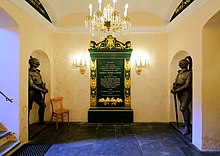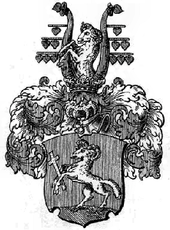Maximilian von Wimpffen

Maximilian Alexander Freiherr von Wimpffen (born February 19, 1770 in Münster , † August 29, 1854 in Vienna ) was an Imperial and Royal Chamberlain , Privy Councilor , Field Marshal and then from 1824 to 1830 chief of the Quartermaster General's staff ( Chief of Staff ) and owner of Infantry Regiment No. 13.
Life
Maximilian von Wimpffen came from the German-Swabian noble family of Wimpffen , he was the son of Lieutenant Field Marshal Franz Georg Siegmund Freiherren von Wimpffen (1735-1816).
In 1781, at the age of eleven, he became a pupil of the Theresian Military Academy in Wiener Neustadt , from which he was retired on November 1, 1786 as a flag cadet to Infantry Regiment No. 9 "Graf von Clerfayt". In the following year he was appointed ensign with a simultaneous transfer to Infantry Regiment No. 19 "Alvinczy". Wimpffen was promoted to lieutenant in this regiment in 1788 and first lieutenant in 1789. Maximilian von Wimpffen took part in the war against the Ottoman Empire (1787–1792) and suffered a serious wound on his left foot from a stone splinter in the assault on Belgrade on September 30, 1789, on which occasion he particularly distinguished himself through courage and bravery. which prevented him from staying with the fighting force. In 1791 he marched with the Morzin Grenadier Battalion to the Netherlands, where he was wounded and taken prisoner in the Battle of Neer winds (1793) . As the nephew of a French general , he was able to achieve a quick dismissal and in the same year take part in the siege of Valenciennes and the battle of Maubeuge . In 1795 he was transferred to northern Italy as a lieutenant captain and a year later he was taken on as a captain in the quartermaster's staff. He was first assigned to General Beaulieu's staff and later to Feldzeugmeister Alvinczy and took part in the meetings of Brenta (November 6, 1796), Caldiero (November 12, 1796) and Arcole (November 15-17, 1796).
In the following years he was involved in the defense of Tyrol and Vorarlberg and was seriously wounded near Taufers in 1799. In the meantime promoted several times, in 1805 he was appointed Colonel of the General Staff to the imperial headquarters and seconded to the corps of Field Marshal Prince Johann von Liechtenstein . When, in spite of his warnings, the battle of Austerlitz was decided, he was given the command of the main column. He was badly wounded in the process. His commitment was rewarded with the Maria Theresa Order . When the war broke out in 1809, he was appointed adjutant general of the main army. After the defeat of the army of Archduke Karl near Regensburg on April 26th, he was appointed chief of the quartermaster staff and promoted to major general. His achievements at Aspern on May 21 and 22, 1809 were recognized by the Archduke with the words that "the first basis of victory lay in the insightful dispositions and the restless use of the chief of the general staff, Major General von Wimpffen". While still on the battlefield, he was awarded the Commander's Cross of the Maria Theresa Order. When, after the Znojmo armistice , Karl resigned from the command of command on July 12, Wimpffen also resigned from his post as chief of staff and took over a brigade in Bohemia.
In the following years he worked in Poland and Transylvania, commanded a division in 1813 and fought in the Battle of Leipzig . On September 2, 1813, he was promoted to Lieutenant Field Marshal . In 1814 he became a military commander in Opava . In 1815 he took part in the campaign in France as a corps commander. After the peace agreement he returned to Troppau. In 1821 he took over the general command in Veneto. From 1824 to 1830 he was again chief of the quartermaster's staff. After completing this task on October 21, 1830 promoted to Feldzeugmeister and owner of Infantry Regiment No. 13, he was commanding general in Lower Austria in his last years of service.
In 1841 the officer became an honorary citizen of Vienna. After the baron had asked for his retirement in 1844, he was appointed field marshal and captain of the first Arcieren bodyguard on December 4, 1844, and on December 5, 1852, in recognition of his long and successful service to the Austrian imperial family awarded the Order of the Golden Fleece .
He was buried on the Heldenberg in Klein-Wetzdorf in Lower Austria , where Radetzky also found his final resting place a little later .
coat of arms
In red on a green background, an upright, silver, crowned ram (declared in another version as a lamb) with golden claws and horns, carrying a golden cross on its forefeet. The same thing is repeated on the crowned helmet, where it grows up between two red buffalo horns hung with golden leaves. The helmet covers are red and silver. *
Appreciations
In Vienna, Wimpffengasse in the Aspern district in Vienna's 22nd district, Donaustadt , commemorates him .
Museum reception
The marshal's baton of Maximilian von Wimpffen, with which he was promoted to field marshal on December 4, 1844, is on display in the Museum of Military History in Vienna .
literature
- Gothaisches genealogical pocket book of baronial houses , 2nd year, Verlag Justus Perthes, Gotha 1849.
- Constantin von Wurzbach : Wimpffen, Maximilian Freiherr . In: Biographisches Lexikon des Kaiserthums Oesterreich . 56th part. Imperial and Royal Court and State Printing Office, Vienna 1888, pp. 252–260 ( digitized version ).
- Julian Pallua-Gall: Wimpffen, Maximilian Freiherr von . In: Allgemeine Deutsche Biographie (ADB). Volume 43, Duncker & Humblot, Leipzig 1898, pp. 327-330.
- Felix Czeike: Historisches Lexikon Wien , Vol. 5, p. 659, Vienna 1997.
- Antonio Schmidt-Brentano: Imperial and Imperial and Royal Generals (1618–1815), Austrian State Archives / A. Schmidt-Brentano 2006.
Web links
- Wimpffen, Maximilian Freiherr von , in Constant von Wurzbach , Biographisches Lexikon des Kaiserthums Oesterreich , 56th volume, page 252, kk Hof- und Staatsdruckerei Vienna 1888.
- Entry on Maximilian von Wimpffen in the Austria Forum (in the AEIOU Austria Lexicon )
Individual evidence
- ^ Antonio Schmidt-Brentano: Imperial and Imperial Generals (1618-1815), Austrian State Archives / A. Schmidt-Brentano 2006, p. 111
- ↑ Archived copy ( memento of the original from September 25, 2013 in the Internet Archive ) Info: The archive link was inserted automatically and has not yet been checked. Please check the original and archive link according to the instructions and then remove this notice.
- ↑ http://www.napoleon-online.de/AU_Generale/html/wimpffen.html
- ^ Fr. Cast: "Historical and genealogical book of the nobles of the Kingdom of Württemberg", Verlag JA Gärtner, Stuttgart 1839, p. 493f
- ^ Ernst Heinrich Kneschke : New general German Adels-Lexicon , Friedrich Voigt'sche Buchhandlung, 6th volume, Loewenthal - Osorowski, Leipzig 1872, p. 578
- ^ Army History Museum / Military History Institute (ed.): The Army History Museum in the Vienna Arsenal . Verlag Militaria , Vienna 2016, ISBN 978-3-902551-69-6 , p. 70
| personal data | |
|---|---|
| SURNAME | Wimpffen, Maximilian von |
| ALTERNATIVE NAMES | Wimpffen, Maximilian Freiherr von |
| BRIEF DESCRIPTION | Austrian field marshal |
| DATE OF BIRTH | February 19, 1770 |
| PLACE OF BIRTH | Muenster |
| DATE OF DEATH | August 29, 1854 |
| Place of death | Vienna |


